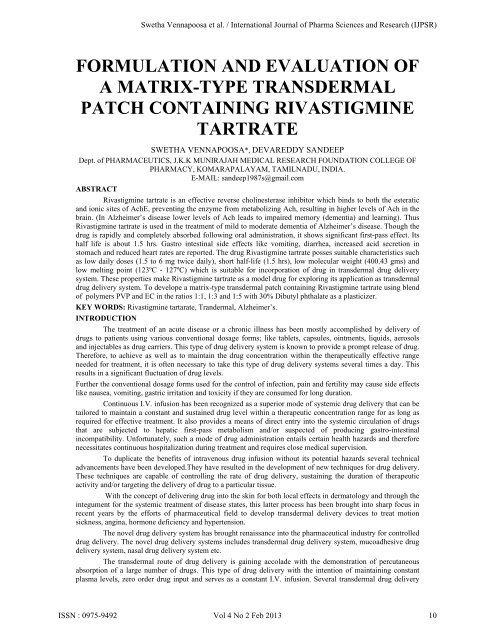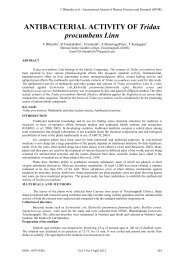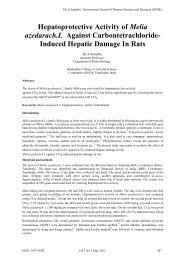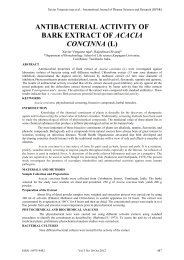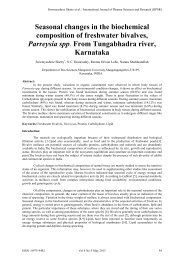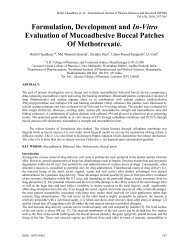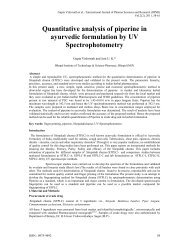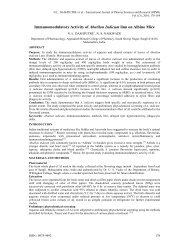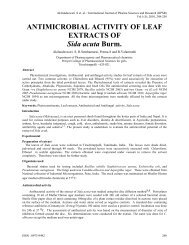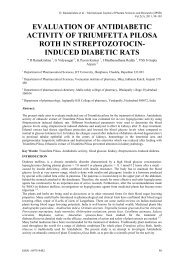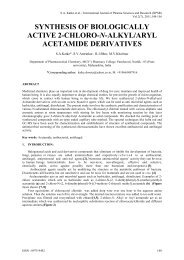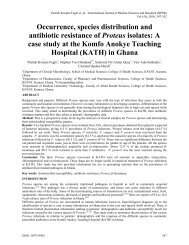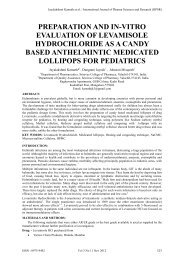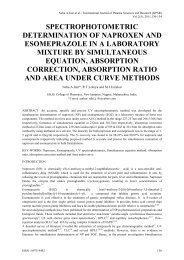formulation and evaluation of a matrix-type transdermal patch ...
formulation and evaluation of a matrix-type transdermal patch ...
formulation and evaluation of a matrix-type transdermal patch ...
You also want an ePaper? Increase the reach of your titles
YUMPU automatically turns print PDFs into web optimized ePapers that Google loves.
Swetha Vennapoosa et al. / International Journal <strong>of</strong> Pharma Sciences <strong>and</strong> Research (IJPSR)<br />
FORMULATION AND EVALUATION OF<br />
A MATRIX-TYPE TRANSDERMAL<br />
PATCH CONTAINING RIVASTIGMINE<br />
TARTRATE<br />
SWETHA VENNAPOOSA*, DEVAREDDY SANDEEP<br />
Dept. <strong>of</strong> PHARMACEUTICS, J.K.K MUNIRAJAH MEDICAL RESEARCH FOUNDATION COLLEGE OF<br />
PHARMACY, KOMARAPALAYAM, TAMILNADU, INDIA.<br />
E-MAIL: s<strong>and</strong>eep1987s@gmail.com<br />
ABSTRACT<br />
Rivastigmine tartrate is an effective reverse cholinesterase inhibitor which binds to both the esteratic<br />
<strong>and</strong> ionic sites <strong>of</strong> AchE, preventing the enzyme from metabolizing Ach, resulting in higher levels <strong>of</strong> Ach in the<br />
brain. (In Alzheimer’s disease lower levels <strong>of</strong> Ach leads to impaired memory (dementia) <strong>and</strong> learning). Thus<br />
Rivastigmine tartrate is used in the treatment <strong>of</strong> mild to moderate dementia <strong>of</strong> Alzheimer’s disease. Though the<br />
drug is rapidly <strong>and</strong> completely absorbed following oral administration, it shows significant first-pass effect. Its<br />
half life is about 1.5 hrs. Gastro intestinal side effects like vomiting, diarrhea, increased acid secretion in<br />
stomach <strong>and</strong> reduced heart rates are reported. The drug Rivastigmine tartrate posses suitable characteristics such<br />
as low daily doses (1.5 to 6 mg twice daily), short half-life (1.5 hrs), low molecular weight (400.43 gms) <strong>and</strong><br />
low melting point (123ºC - 127ºC) which is suitable for incorporation <strong>of</strong> drug in <strong>transdermal</strong> drug delivery<br />
system. These properties make Rivastigmine tartrate as a model drug for exploring its application as <strong>transdermal</strong><br />
drug delivery system. To develope a <strong>matrix</strong>-<strong>type</strong> <strong>transdermal</strong> <strong>patch</strong> containing Rivastigmine tartrate using blend<br />
<strong>of</strong> polymers PVP <strong>and</strong> EC in the ratios 1:1, 1:3 <strong>and</strong> 1:5 with 30% Dibutyl phthalate as a plasticizer.<br />
KEY WORDS: Rivastigmine tartarate, Tr<strong>and</strong>ermal, Alzheimer’s.<br />
INTRODUCTION<br />
The treatment <strong>of</strong> an acute disease or a chronic illness has been mostly accomplished by delivery <strong>of</strong><br />
drugs to patients using various conventional dosage forms; like tablets, capsules, ointments, liquids, aerosols<br />
<strong>and</strong> injectables as drug carriers. This <strong>type</strong> <strong>of</strong> drug delivery system is known to provide a prompt release <strong>of</strong> drug.<br />
Therefore, to achieve as well as to maintain the drug concentration within the therapeutically effective range<br />
needed for treatment, it is <strong>of</strong>ten necessary to take this <strong>type</strong> <strong>of</strong> drug delivery systems several times a day. This<br />
results in a significant fluctuation <strong>of</strong> drug levels.<br />
Further the conventional dosage forms used for the control <strong>of</strong> infection, pain <strong>and</strong> fertility may cause side effects<br />
like nausea, vomiting, gastric irritation <strong>and</strong> toxicity if they are consumed for long duration.<br />
Continuous I.V. infusion has been recognized as a superior mode <strong>of</strong> systemic drug delivery that can be<br />
tailored to maintain a constant <strong>and</strong> sustained drug level within a therapeutic concentration range for as long as<br />
required for effective treatment. It also provides a means <strong>of</strong> direct entry into the systemic circulation <strong>of</strong> drugs<br />
that are subjected to hepatic first-pass metabolism <strong>and</strong>/or suspected <strong>of</strong> producing gastro-intestinal<br />
incompatibility. Unfortunately, such a mode <strong>of</strong> drug administration entails certain health hazards <strong>and</strong> therefore<br />
necessitates continuous hospitalization during treatment <strong>and</strong> requires close medical supervision.<br />
To duplicate the benefits <strong>of</strong> intravenous drug infusion without its potential hazards several technical<br />
advancements have been developed.They have resulted in the development <strong>of</strong> new techniques for drug delivery.<br />
These techniques are capable <strong>of</strong> controlling the rate <strong>of</strong> drug delivery, sustaining the duration <strong>of</strong> therapeutic<br />
activity <strong>and</strong>/or targeting the delivery <strong>of</strong> drug to a particular tissue.<br />
With the concept <strong>of</strong> delivering drug into the skin for both local effects in dermatology <strong>and</strong> through the<br />
integument for the systemic treatment <strong>of</strong> disease states, this latter process has been brought into sharp focus in<br />
recent years by the efforts <strong>of</strong> pharmaceutical field to develop <strong>transdermal</strong> delivery devices to treat motion<br />
sickness, angina, hormone deficiency <strong>and</strong> hypertension.<br />
The novel drug delivery system has brought renaissance into the pharmaceutical industry for controlled<br />
drug delivery. The novel drug delivery systems includes <strong>transdermal</strong> drug delivery system, mucoadhesive drug<br />
delivery system, nasal drug delivery system etc.<br />
The <strong>transdermal</strong> route <strong>of</strong> drug delivery is gaining accolade with the demonstration <strong>of</strong> percutaneous<br />
absorption <strong>of</strong> a large number <strong>of</strong> drugs. This <strong>type</strong> <strong>of</strong> drug delivery with the intention <strong>of</strong> maintaining constant<br />
plasma levels, zero order drug input <strong>and</strong> serves as a constant I.V. infusion. Several <strong>transdermal</strong> drug delivery<br />
ISSN : 0975-9492 Vol 4 No 2 Feb 2013 10
Swetha Vennapoosa et al. / International Journal <strong>of</strong> Pharma Sciences <strong>and</strong> Research (IJPSR)<br />
system (TDDS) have recently been developed aiming to achieve the objective <strong>of</strong> systemic medication through<br />
application to the intact skin.<br />
The intensity <strong>of</strong> interest in the pontential bio-medical application <strong>of</strong> <strong>transdermal</strong> controlled drug<br />
administration is demonstrated in the increasing research activities in a number <strong>of</strong> health care institutions in the<br />
development <strong>of</strong> various <strong>type</strong>s <strong>of</strong> <strong>transdermal</strong> therapeutic systems(TTS) for long term continuous infusion <strong>of</strong><br />
therapeutic agents including antihypertensives, antianginal, anti-histamine, anti-inflammatory , analgesic drugs<br />
etc.<br />
“Transdermal drug delivery systems are adhesive, drug containing devices <strong>of</strong> defined surface area that<br />
deliver a pre-determined amount <strong>of</strong> drug to the surface <strong>of</strong> intact skin at a pre-programmed rate. These systems<br />
provide drug systemically at a predictable rate <strong>and</strong> maintain the rate for extended periods <strong>of</strong> time.<br />
The skin acts as a formidable barrier to the penetration <strong>of</strong> drugs <strong>and</strong> other chemicals, it does have<br />
certain advantages which make it an alternative route for systemic delivery <strong>of</strong> drugs. Transdermal drug delivery<br />
system involves the passage <strong>of</strong> substances from the skin surface through the skin layers, into the systemic<br />
circulation. The skin has been commonly used as a site for topical administration <strong>of</strong> drugs, when the skin serves<br />
as a port for administration <strong>of</strong> systemically active drugs. The drug applied topically is distributed following<br />
absorption, first into the systemic circulation <strong>and</strong> then transported to the target tissue, which can be relatively<br />
remote from the site <strong>of</strong> drug application to achieve its therapeutic action.(Chien Yie W. Transdermal drug<br />
delivery <strong>and</strong> delivery systems,1992 1,2,3 .<br />
Methods to enhance permeation<br />
1. Chemical methods<br />
2. Physical methods<br />
1. Chemical means <strong>of</strong> <strong>transdermal</strong> penetration enhancement:<br />
In this method various chemicals are used to enhance the permeation across the skin which acts as a tough<br />
barrier. Ex: DMSO, menthol, limonene, etc.<br />
Mechanism:<br />
The enhancement in absorption <strong>of</strong> oil soluble drugs is apparently due to the partial leaching <strong>of</strong> the<br />
epidermal lipids by the chemical enhancers, resulting in the improvement <strong>of</strong> the skin conditions for wetting <strong>and</strong><br />
for transepidermal <strong>and</strong> transfollicular penetration. The miscibility <strong>and</strong> solution properties <strong>of</strong> the enhancers used<br />
could be responsible for the enhanced <strong>transdermal</strong> permeation <strong>of</strong> water-soluble drugs. Some <strong>of</strong> them alter the<br />
composition <strong>of</strong> the cell content while others effect the cohesiveness between cells <strong>and</strong> composition <strong>of</strong><br />
intercellular material or have a direct effect on cell membrane. The composition <strong>of</strong> intercellular lipids undergo a<br />
solid-lipid phase transition at 40°c. it is possible that some penetration enhancers act to disrupt the structure <strong>of</strong><br />
intercellular lipids <strong>and</strong> lower the phase transition temperature, thereby increasing the permeability <strong>of</strong> skin to<br />
more polar compounds. To increase the rate <strong>of</strong> transfer <strong>of</strong> lipophilic compounds, it is necessary to modify the<br />
partitioning characteristics at the stratum corneum viable tissue interface. This may be possible by combining a<br />
penetration enhancer with a co-solvent. Some agents can establish a reservoir in stratum corneum, which may<br />
facilitate diffusion <strong>of</strong> drug, when penetrating the epidermis, may carry drug through, by acting as a solvent<br />
(Swarna lata soni <strong>and</strong> Vinod KD,1992). Many <strong>of</strong> these agents may act by a combination <strong>of</strong> various effects on<br />
the skin while others may be involved in a direct chemical insult on the skin, When the specified lipid film,<br />
made up <strong>of</strong> sebaceous secretion, desquamated cells, sweats <strong>and</strong> other components, the percutaneous absorption<br />
is enhanced slightly. When lipids are removed from the skin as by means <strong>of</strong> prolonged exposure to polar<br />
solvents, however, considerably enhanced absorption <strong>of</strong> applied materials. it is quite likely that lipid solvents<br />
must damage the lipid portion <strong>of</strong> the membrane before much change in passage through the skin can take place.<br />
The existence <strong>of</strong> a depot or reservoir for topically applied drugs within the stratum corneum was postulated by<br />
Malkinson <strong>and</strong> Furgoson. 4,5 .<br />
Classification <strong>of</strong> penetration enhancers:<br />
1. Terpenes(essential oils) : Nerodilol, menthol, 1 8 cineol,limonene, carvone etc.<br />
2. Pyrrolidones : N-methyl-2-pyrrolidone(NMP), azone etc.<br />
3. Fatty acids <strong>and</strong> esters : Oleic acid, linoleic acid, lauric acid, capric acid etc.<br />
4. Sulfoxides <strong>and</strong> similar compounds : Dimethyl sulfoxide(DMSO), N,Ndimethyl formamide<br />
5. Alcohols, Glycols, <strong>and</strong> Glycerides : Ethanol, Propylene glycol, Octyl alcohol etc.<br />
6. Micellaneous enhancers : Phospholipids,Cyclodextrins,Aminoacidderivatives,Enzymes etc.<br />
ISSN : 0975-9492 Vol 4 No 2 Feb 2013 11
Swetha Vennapoosa et al. / International Journal <strong>of</strong> Pharma Sciences <strong>and</strong> Research (IJPSR)<br />
2. Physical means <strong>of</strong> penetration enhancement:<br />
The permeation <strong>of</strong> drugs across the skin is enhanced by physical means like pulsed DC iontophorosis<br />
or effect <strong>of</strong> ultrasounds may have synergistic effect depending upon the current density <strong>of</strong> pulse current applied<br />
<strong>and</strong> ultrasound intensity time e.g. Ragel’s studied the penetration <strong>of</strong> tetracycline into the tissues subject to<br />
electro <strong>and</strong> phonphoresis. It was found that tissue levels <strong>of</strong> tetracycline administered by the use <strong>of</strong> both electro<br />
<strong>and</strong> phonphoresis were higher than those obtained by the use <strong>of</strong> either electro <strong>of</strong> phonphoresis alone 6,7,8 .<br />
Technologies in the development <strong>of</strong> TDDS.<br />
A. Membrane moderated systems:<br />
In this, the drug reservoir is totally encapsulated in a shallow compartment molded from a drug<br />
impermeable metallic plastic laminate <strong>and</strong> a rate controlling polymeric membrane. In the drug reservoir<br />
compartment, the drug solids are either dispersed in a solid polymer <strong>matrix</strong> or suspended in an unleachable,<br />
viscous liquid medium e.g. silicon fluid. The rate controlling membrane can be micro porous or nonporous<br />
polymeric membrane e.g. ethylene vinyl acetate co-polymer on the external surface <strong>of</strong> the polymeric membrane,<br />
a skin layer <strong>of</strong> drug, compatible hypo allergic adhesive polymer may be applied to achieve an intimate contact<br />
<strong>of</strong> TDDS with skin surface 9,10 .<br />
Marketed systems<br />
• Transderm-Nitro system for once a day.<br />
• Transderm-Scop system- 3 days medication.<br />
• Catapres- TTS – for weekly treatment.<br />
B. Adhesive diffusion controlled system<br />
It is the simplest version <strong>of</strong> the membrane moderated drug delivery systems. In this system the drug<br />
reservoir is formulated by directly dispersing the drug in an adhesive polymer <strong>and</strong> then spreading the medicated<br />
adhesive by solvent casting onto a flat sheet <strong>of</strong> drug impermeable metallic plastic backing to form thin drug<br />
reservoir layer. On the top <strong>of</strong> the reservoir layer, layers <strong>of</strong> non-medicated rate controlling adhesive polymer <strong>of</strong><br />
constant thickness are applied.<br />
Marketed devices.<br />
Deponit system <strong>and</strong> Fr<strong>and</strong>ol tape<br />
C. Matrix dispersion:<br />
Here the drug reservoir is formed by homogeneously dispersing the drug solids in a hydrophilic or<br />
lipophilic polymer <strong>matrix</strong> <strong>and</strong> medicated polymer is then molded into disc with defined area <strong>and</strong> thickness. This<br />
is glued onto an occlusive base plate on the surface <strong>of</strong> the disc, the adhesive polymer is spread along the<br />
circumference to form a stripe <strong>of</strong> adhesive rim around the disc.<br />
D. Micro-reservoir system:<br />
These are considered as combination <strong>of</strong> reservoir <strong>and</strong> <strong>matrix</strong> dispersion <strong>type</strong>. In this the drug reservoir<br />
is formed by first suspending the drug solids in an aqueous solution <strong>of</strong> water soluble polymer <strong>and</strong> then<br />
dispersing the drug suspension homogenously in lipophilic polymer, by high shear mechanical force to form<br />
unleachable microscopic spheres <strong>of</strong> drug reservoir. This dispersion is stabilized immediately by cross-linking<br />
the polymer chains which produces a medicated disc with constant surface area <strong>and</strong> thickness 11,12,13 .<br />
AIM AND OBJECTIVE OF THE STUDY<br />
The present work is planned with the following objectives:<br />
‣ To develope a <strong>matrix</strong>-<strong>type</strong> <strong>transdermal</strong> <strong>patch</strong> containing Rivastigmine tartrate using blend <strong>of</strong> polymers<br />
PVP <strong>and</strong> EC in the ratios 1:1, 1:3 <strong>and</strong> 1:5 with 30% Dibutyl phthalate as a plasticizer.<br />
‣ To evaluate, the <strong>transdermal</strong> systems for their physical appearance, moisture content, moisture uptake,<br />
thickness, area etc.<br />
‣ To produce the economical <strong>patch</strong>es for the poor people, by using simple <strong>and</strong> economical polymers.<br />
‣ To study In-vitro drug release to ensure drug release was controlled <strong>and</strong> prolonged over a period <strong>of</strong><br />
time.<br />
‣ To lessen the side-effects by using Rivastigmine tartrate containing <strong>transdermal</strong> <strong>patch</strong>es in comparison<br />
to newer analogues in treating Alzheimer’s disease.<br />
METHODOLOGY<br />
Formulation studies<br />
Preparation <strong>of</strong> backing membrane<br />
The backing membrane was prepared using an aqueous solution <strong>of</strong> a 6 % w/v <strong>of</strong> polyvinyl alcohol (PVA)<br />
(S.d Fine Chemicals, Boisar, India). Weighed amount <strong>of</strong> polyvinyl alcohol was added to a definite volume <strong>of</strong><br />
ISSN : 0975-9492 Vol 4 No 2 Feb 2013 12
Swetha Vennapoosa et al. / International Journal <strong>of</strong> Pharma Sciences <strong>and</strong> Research (IJPSR)<br />
warm glass-distilled water <strong>and</strong> was constantly stirred on a magnetic stirrer at 60°C for few min without<br />
formation <strong>of</strong> bubbles to attain a homogeneous solution. 3 ml <strong>of</strong> homogeneous solution was then poured into<br />
glass cylindrical mold (3.3cm length, 2.3cm internal diameter) to one <strong>of</strong> the open end which was wrapped by<br />
aluminum foil. Smooth uniform, transparent backing membrane was obtained after keeping the mold at 60°C for<br />
6 hours 14,15 .<br />
Formation <strong>of</strong> drug <strong>matrix</strong> over the backing membrane<br />
Blend <strong>of</strong> polymers PVP <strong>and</strong> EC were measured in the requisite ratios <strong>of</strong> 1:1, 1:3 <strong>and</strong> 1:5 <strong>and</strong> were<br />
dissolved in chlor<strong>of</strong>orm in each case [Mukherjee et al.,2006]. A homogeneous solution was made using a<br />
magnetic stirrer <strong>and</strong> a magnetic bead. Rivastigmine tartrate was added to each mixture <strong>and</strong> stirred for 20 min<br />
until a homogeneous suspension was obtained. 3 ml <strong>of</strong> the homogeneous suspension was then casted on the<br />
prepared backing membrane <strong>and</strong> dried at room temperature for 24 h, which yielded a uniform, flat medicated<br />
<strong>matrix</strong> <strong>patch</strong> <strong>of</strong> Rivastigmine tartrate 16,17 .<br />
Formula:<br />
Ingredients F1(%w/w) F2 (%w/w) F3(%w/w)<br />
PVP 2.5 2.5 2.5<br />
EC 2.5 7.5 12.5<br />
Dibutyl phthalate 2.85 2.85 12.85<br />
Drug 1.52 1.52 1.52<br />
Chlor<strong>of</strong>orm 90.63 85.63 70.63<br />
In Vitro studies <strong>of</strong> Rivastigmine tartrate Patches<br />
In vitro drug release studies:<br />
The release studies were performed using a modified Franz diffusion cell assembly. The backing<br />
membrane side <strong>of</strong> the <strong>patch</strong>es was stuck on a parafilm membrane which was bigger than the actual size <strong>of</strong> the<br />
<strong>patch</strong> with the help <strong>of</strong> a water impermeable adhesive. The release liner was removed <strong>and</strong> the <strong>patch</strong> was mounted<br />
on the diffusion cell with the <strong>patch</strong> facing the receptor compartment. The receptor compartment was filled with<br />
propylene glycol <strong>and</strong> phosphate buffer (pH 7.4) in ratio <strong>of</strong> 1:1 <strong>and</strong> maintained at 37 ◦C. The receptor medium<br />
was continuously stirred at 600rpm <strong>and</strong> 0.5 ml <strong>of</strong> receptor solution was taken for each sample time point which<br />
was immediately replaced with fresh receptor solution. The samples were analyzed using the respective HPLC<br />
methods 18,19,20 .<br />
RESULTS<br />
S.No. Concentration (μg/ml) Absorbance(nm)<br />
1 0 0.000<br />
2 2 0.032<br />
3 4 0.064<br />
4 6 0.095<br />
5 8 0.125<br />
Table 1. Spectrophotometric data for construction <strong>of</strong> st<strong>and</strong>ard graph <strong>of</strong> Rivastigmine tartrate<br />
ISSN : 0975-9492 Vol 4 No 2 Feb 2013 13
Swetha Vennapoosa et al. / International Journal <strong>of</strong> Pharma Sciences <strong>and</strong> Research (IJPSR)<br />
0.14<br />
0.12<br />
0.1<br />
0.08<br />
Absorbance<br />
(nm)<br />
0.06<br />
0.04<br />
0.02<br />
0<br />
0 2 4 6 8 10<br />
Sl.No.<br />
Drug<br />
name<br />
Concentration (µg/ml)<br />
Fig 1. st<strong>and</strong>ard graph <strong>of</strong> Rivastigmine tartrate<br />
Solubility<br />
(mg/ml)<br />
Water<br />
Melting<br />
point<br />
(ºC)<br />
Buffer<br />
pH 7.4<br />
Partition<br />
coefficient<br />
Log P<br />
1 Rivastigmine tartrate 124 ºC 642.28 743.38 2.611<br />
S.No.<br />
Formulation<br />
codes<br />
Table -2 Pre<strong>formulation</strong> studies <strong>of</strong> Rivastigmine tartrate<br />
Physical<br />
appearance<br />
* Weight<br />
(mg)<br />
* Moisture<br />
content<br />
*% Moisture<br />
uptake capacity<br />
(%)<br />
1 F1 ++ 351.45 ± 0.84 4.8±0.20 5.4±0.23<br />
2 F2 ++ 351.1 ± 0.73 2.47±0.39 2.95±0.42<br />
3 F3 ++ 351.42 ± 0.54 1.56±0.13 1.72±0.17<br />
* → Average <strong>of</strong> five observations<br />
++ → Satisfactory<br />
Table-3 Evaluation parameters <strong>of</strong> the <strong>transdermal</strong> systems<br />
Mean diameter <strong>of</strong> <strong>patch</strong> (cm) ± SD<br />
Mean area <strong>of</strong> <strong>patch</strong> (cm 2 ) ± SD<br />
(n = 10)<br />
(n = 10)<br />
2.34 ± 0.032 4.19 ± 0.06<br />
Table -4 Average area <strong>of</strong> Rivastigmine tartrate <strong>patch</strong>es<br />
ISSN : 0975-9492 Vol 4 No 2 Feb 2013 14
Swetha Vennapoosa et al. / International Journal <strong>of</strong> Pharma Sciences <strong>and</strong> Research (IJPSR)<br />
Formulation<br />
Code<br />
Mean thickness<br />
<strong>of</strong> whole <strong>patch</strong><br />
(in mm) ± SD (n<br />
= 5)<br />
Mean thickness <strong>of</strong><br />
backing membrane(in<br />
mm) ± SD (n = 5)<br />
Mean thickness <strong>of</strong> polymer<br />
<strong>matrix</strong> (in mm) ± SD (n = 5)<br />
F1 0.552±0.03 0.259±0.0063 0.293±0.017<br />
F2<br />
F3<br />
0.573±0.03<br />
0.597±0.02<br />
0.261±0.0087<br />
0.276±0.041<br />
0.312±0.014<br />
0.321±0.012<br />
Table -5 Thickness <strong>of</strong> Rivastigmine tartrate <strong>transdermal</strong> <strong>patch</strong>es<br />
% Cumulative drug release (Time in Hours)<br />
Time (Hr) PVP:EC (1:1) PVP:EC (1:3) PVP:EC (1:5)<br />
(F1)<br />
(F2)<br />
(F3)<br />
0 0 0 0<br />
1 19.73 12.67 8.97<br />
2 24.97 18.87 14.76<br />
3 32.42 23.98 19.54<br />
4 39.88 28.43 22.98<br />
5 45.63 34.78 27.84<br />
6 51.45 46.09 35.67<br />
12 78.05 61.32 54.98<br />
24 93.65 84.79 79.12<br />
36 94.77 91.57<br />
Table -6 Invitro drug release studies (Rivastigmine tartrate <strong>transdermal</strong> <strong>patch</strong>es)<br />
Conclusion<br />
Rivastigmine tartrate is a reversible cholinesterase inhibitor used for the treatment <strong>of</strong> mild to moderate<br />
dementia <strong>of</strong> alzheImer’s disease ,which is having a short half-life about 1.5 hours which causes increased<br />
frequency <strong>of</strong> dosing.The <strong>matrix</strong> film fomers PVP <strong>and</strong> EC in the ratio <strong>of</strong> 1:1,1:3 <strong>and</strong> 1:5 were used here to<br />
develop transermal <strong>matrix</strong> pattern <strong>of</strong> Rivastigmine tartrate as these ratios were found to be acceptable in terms<br />
<strong>of</strong> tackiness <strong>and</strong> consistency by our earlier study (Mukeerjee Et al 2006). Further no predominant interaction<br />
was detected between the mixture <strong>of</strong> pure drug <strong>and</strong> combination <strong>of</strong> polymers using FT-IR spectroscopy. Various<br />
data <strong>of</strong> the pharmaco technical parameters generated from this study such as thickness, moisture content,<br />
moisture uptake, <strong>patch</strong> area <strong>and</strong> weight uniformity were found to be favourable to the development <strong>of</strong><br />
<strong>transdermal</strong>,<strong>matrix</strong> <strong>patch</strong>es in case <strong>of</strong> all the three <strong>formulation</strong>s F1,F2,<strong>and</strong> F3 but F3 was found to be more<br />
suitable with slow drug release for the development <strong>of</strong> <strong>transdermal</strong> <strong>patch</strong>es.<br />
Invitro drug release studies revealed that the <strong>formulation</strong> F3 provided sustained release for drug<br />
molecules due to increase in amount <strong>of</strong> EC in the <strong>formulation</strong>. A more or less similar trend was studied in case<br />
<strong>of</strong> F2 <strong>formulation</strong> <strong>and</strong> F1 <strong>formulation</strong>. When the average rate constant <strong>of</strong> these 3 <strong>formulation</strong>s were compared it<br />
was found that F3(PVP:EC -1:5)had the slowest release rate <strong>of</strong> all the <strong>formulation</strong>s studied. Therefore based on<br />
the above observations it can be reasonably concluded that PVP-EC (1:5)polymers are better suited over PVP-<br />
ISSN : 0975-9492 Vol 4 No 2 Feb 2013 15
Swetha Vennapoosa et al. / International Journal <strong>of</strong> Pharma Sciences <strong>and</strong> Research (IJPSR)<br />
EC (1:1 &1:3) for the development <strong>of</strong> TDDS <strong>of</strong> Rivastigmine Tartrate. Hence the <strong>formulation</strong> F3 (PVP:EC, 1:5)<br />
may be used for further pharmokinetic <strong>and</strong> pharmacodynamic studies in suitable animal models.<br />
REFERENCES<br />
[1] Ainlay wade, Paul J wells ,1994.H<strong>and</strong>book <strong>of</strong> pharmaceutical excipients. 2nd ed.<br />
[2] Alfred Martin, James Swarbrick, Arthur Cammarata,1991. Polymer Science. 3rd ed.<br />
[3] Bombay: K. M. Varghese company.<br />
[4] Atherden LM, 2002. Analytical methods. 8th ed. Oxford medical publication.<br />
[5] Ballard C, Margallo-Lana M, Juszczak E, Douglas S, Swann A, Thomas A, O’ Brien J, Everralt A, Sadler S, Maddisen C, Lu L,<br />
Bannistic C, Elvish R, Jacoby R Quetiapine <strong>and</strong> Rivastigmine <strong>and</strong> Cognitive decline in ALzhimer’s Disease: R<strong>and</strong>omised double blind<br />
placebo controlled trial – Institute <strong>of</strong> Psyciatry, Kings College, London.<br />
[6] Barry BW, 1987. Mode <strong>of</strong> action <strong>of</strong> penetration enhancers in human skin. J Controlled Rel; 6: 85-97.<br />
[7] Bhaskar P, Krishnaiah YSR <strong>and</strong> Vijaya ratna J, 2004. Transdermal drug delivery: Role <strong>of</strong> chemical penetration enhancers. J Pharma<br />
Excip: 6-15.<br />
[8] Bradley R. Williams Pharm D, Arlette Nazarians, Pharm D <strong>and</strong> Mark a Gill Pharm D. A Reversible Cholinesterase Inhibitor ;<br />
Department <strong>of</strong> Pharmacy <strong>and</strong> Gerentology, University <strong>of</strong> South Carolina School <strong>of</strong> Pharmacy, Los Angeles, California., pg 1634-1653<br />
[9] Burns .A, Spiegel R. <strong>and</strong> Quarg P, 2004.Efficacy <strong>of</strong> Rivastigmine in Subjects with Moderately Severe Alzhimer’s Disease ,<br />
Interntional Journal <strong>of</strong> Geriatric Psychiatry; 19; 243-249<br />
[10] Carpel MC, Erasmo AME, Rawena SW, Elizebath PH, Rondoll Z. 1987.Drug Intelligence Clinical Pharmacy.<br />
[11] Chien Yie W. 1992.Concepts <strong>and</strong> system design for rate controlled drug delivery. 2nd ed. New York : Marcel Dekker Inc.<br />
[12] Chien Yie W. 1992.Parenteral drug delivery <strong>and</strong> delivery systems. 2nd ed. New York : Marcel Dekker Inc.<br />
[13] Chien Yie W. 1992.Transdermal drug delivery <strong>and</strong> delivery systems. 2nd ed. New York : Marcel Dekkar Inc.<br />
[14] Chien YW,1991.Systemic drug delivery <strong>of</strong> pharmacologically active molecule across the skin. Vol 100. New york.<br />
[15] Choudhary KPR, <strong>and</strong> Naidu RAS, 1991. Studies on permeability <strong>of</strong> ethyl cellulose filmsfor <strong>transdermal</strong> use. The eastern pharmacist;<br />
34(405): 119-21.<br />
[16] Davidson’s Principles <strong>and</strong> Practice <strong>of</strong> Medicine 20 th Edition, edited by Nicholas.A.Boon, Nicki.R.Colledge, Brian.R.Walker,<br />
International Editor John A.A. Hunter pg 1217, 1188, 1189<br />
[17] Devy K, Paranjothy KLK. 1999. Pharmacokinetic pr<strong>of</strong>ile <strong>of</strong> a new <strong>matrix</strong> <strong>type</strong> <strong>transdermal</strong> delivery system: Dicl<strong>of</strong>enac<br />
diethylammonium <strong>patch</strong>. Drug.Dev.Ind.Pharm 25: 695-700.<br />
[18] Fang JY, Wamg RJ, Wu PC, Jsai YH, 2000.Passive <strong>and</strong> iontophoretic delivery <strong>of</strong> three dicl<strong>of</strong>enac salts across various skin <strong>type</strong>s. Bio<br />
Pharm Bul; 23: 1357-1362.<br />
[19] Flynn GL, Durrheim H, Huguchi WI, 1981. Permeation through hairless mouse skin II: membrane sectioning techniques <strong>and</strong> influence<br />
on alkanol permeabilities. J Pharm Sci; 70 (1): 52-56.<br />
[20] Frankfurt S.V Pharm D, Appels B.A. M.Sc, A. de Boer MD., Phd, Tulner L.R. M.D, J.P.C.M Van Campen MD, C:H. W Koks Pharm<br />
D, PhD, J.H. Beijnen Pharm D, PhD <strong>and</strong> B.A Schne<strong>and</strong> PhD, Pharmacoepidemiology <strong>and</strong> Drug Safety (in press) DOT:10.1002/pds<br />
1345; Identification <strong>of</strong> Responders <strong>and</strong> Reactive domains to Rivastigmine in Alzhimer’s Disease<br />
ISSN : 0975-9492 Vol 4 No 2 Feb 2013 16


